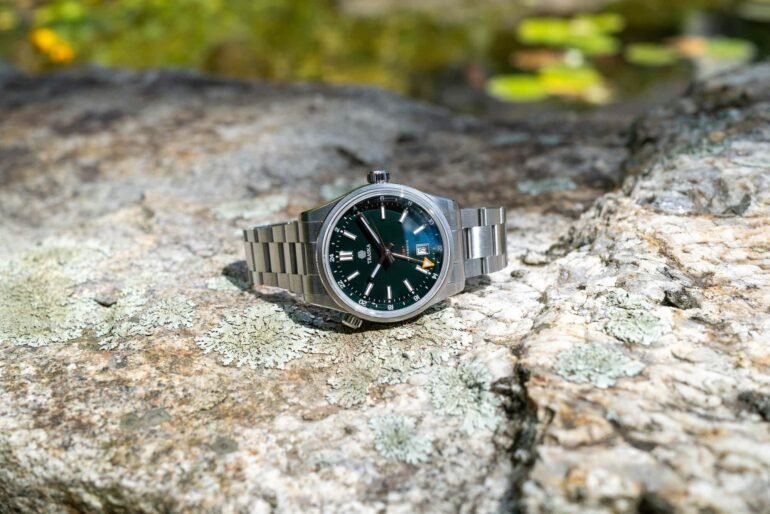I’m not a big “upgrader.” I’ve never been hugely interested in having the latest thing. My style of collecting (or, arguably, of “accumulating”) has always come more from a deep-seated urge for completionism, rather than a desire always to have the best or newest. When I do take the plunge on something, I try to get exactly what I want, or the best option available, and then, typically, I’m pretty happy with it.
It’s why I’m still using the iPhone 12 Pro Max I bought five years ago (it works perfectly), why I was totally comfortable — in buying my first gravel bike this summer — to opt for an older model year of the Cannondale Topstone instead of the shiniest brand new version, and why I’ve felt absolutely no urge to pick up a more recent iteration of my beloved Omega Seamaster. Still, occasionally, a meaningful update comes along that genuinely grabs my attention. Most recently, that happened with the watch I’m reviewing here: the Traska Venturer GMT, now in its sixth generation.
There was a time, when watches and writing were a hobby and not a vocation, that I was the “NWA-every-other-week” type, but as my collecting has slowed down, and since I’m lucky enough to satisfy much of my urge for novelty through work, I’m much more restrained in my purchasing habits. The result of this is that I’ve somewhat fallen off the microbrand treadmill, the constant in and out of FedEx boxes from my house now primarily a professional concern, rather than a matter of personal edification, and the watches I spend time with are often dictated more by editorial decisions than by my own interest.
So I’ve missed things, and that’s a bit of a bummer, because microbrand offerings are better today than they’ve ever been, and I’m probably (certainly) missing out on owning some very cool watches for giving up on the constant in-and-out it takes to experience everything — or even an approximation — of everything that’s out there. Still, it’s a world I love, and so when, back in June, I was looking to pick up something simple and new for the summer, it felt like a great time to turn my gaze back towards the microbrand scene.
Traska, Take 1 (or Technically 2)
That’s how I ended up owning a used Traska Venturer GMT. My white dialed Traska is an older reference, a second-gen ref. 4212, but it’s an impressive watch. It was one of only three watches I brought with me on a nearly month-long trip earlier this summer, and it impressed me on nearly all counts. But it had a few niggling issues I just couldn’t get past, so when it came time to write about the watch, I reached out to Traska and was thrilled when they offered to loan me the latest iteration of the Venturer, which recently came available for sale (and is, at the time of writing, currently sold out in most colors).
I’m immensely grateful that they did, because the green dialed version that arrived on my doorstep, direct from the brand, isn’t just the small update I expected; it’s a night-and-day improvement on the earlier version, and a perfect synthesis of how microbrand offerings have improved dramatically in recent years. It’s also a wicked value proposition, and makes for one of the best all-around watches I’ve experienced recently, especially under $1000.
Okay, so I can see how reading that last paragraph might give you the wrong impression about my earlier version of the Venturer GMT, so let me be clear about one thing up front: The ref. 4212 Venturer GMT is a great watch, full stop. In fact, if Traska had stopped developing the model back when the 4212 came out, I’d still recommend the watch, and if you manage to snag one for a great price on the secondary market, you’ll have done really well for yourself.
The 4212 is a real goldilocks option for many: a handsome, robust, and functional everyday travel watch. It was also a huge step forward when compared to the first-generation Venturer, especially if you start to consider functionality. The first-generation Venturer, despite an internally rotating 12-hour bezel, wasn’t a GMT and was somewhat limited in its utility as a GADA travel watch. But the inclusion of the Miyota 9075 flyer-GMT caliber in its follow-up transformed the Venturer from being a cool, kinda funky, three-hander into what may just be my favorite affordable GMT anywhere on the market. But, as I said, despite getting way more right than it got wrong, the 4212 wasn’t perfect. Still, it was close, and the best evidence of that is just how few small changes took the Venturer GMT from being a really very good watch to being an absolutely great one.
The Elephant in the Room (or is it a Crown?)
But before we get into any of that, there is one thing that probably needs to be addressed: The Traska Venturer GMT looks an awful lot like the Rolex Oyster Perpetual. From the case shape and Oyster-style bracelet, to the markers and hands, the Venturer owes a lot to the classic OP. Even the side profile of the crown is reminiscent of that found on just about every Rolex Oyster model for the last few decades.
That’s gonna be a dealbreaker to some. And if I’d spent less time with the Traska, it also would have been for me. I’ve never been a fan of homage watches (I’ve always felt that, for the price you pay for a good homage, you can open up a world of original design), and at first glance, it’s hard to get around how much the Venturer looks — and even feels — like a Rolex. Even the deep bottle green dial of the Traska currently on my wrist feels like a color one might someday find offered in a Rolex boutique.
If that’s a barrier for you, I totally get it. It’s a fair hit, and I’m not going to sit here and try and talk my way around the issue. But the longer I’ve worn the watch, the less I care about any visual similarities between the two brands. I actually kinda love it, not because I feel like I’m getting away with anything or that the Venturer is riding on Rolex’s shine, but because Traska has done something awesome with the Venturer GMT. They’ve identified and distilled what makes a Rolex feel like a Rolex, and used that knowledge to create a watch Rolex should’ve been making for years.
Basically? They beat Rolex to the punch, and they should be celebrated for that. They found a hole in the Rolex catalog, and they filled it, and I’m glad they did, because if Rolex wasn’t going to figure out that they should be making this watch, I’m thrilled someone did.
The Latest Traska Venturer GMT
When I got my Traska earlier this summer, I was thrilled by it. The 39mm case was exactly the right size (and is a great reminder that Rolex should not have discontinued the 39mm OP — last mention of Rolex, I promise). The restrained execution of the GMT complication integrated beautifully with the other dial furniture, the second crown was a great indication that something “more” was going on than you’d get from a three-hand sports watch, and the icy white dial with touches of gray and pops of blue made for a handsome pick that went with everything and never felt out of place.
The recipe was right, but while I was taken with the watch, I saw issues, too, and I saw them immediately. It’s really easy, from my position, to pick apart a watch. Call it an occupational hazard, but spend enough time critiquing anything and it gets really easy to see what’s wrong with something instead of what’s great about it.
The lack of a screw-down — or even push-pull — crown at 10 o’clock meant the internal bezel floated away from where it was set far too often, so the third time zone tracking was fundamentally useless. The clasp and bracelet were nice (and included adjustment by single-sided screws!), but without any on-the-fly adjustability, the watch was only going to fit well when the weather played nice. Not a problem on a watch meant to be worn close to home, but a serious issue on what may be the only watch you take on an international trip.
And from the side? For as good as the case looked head-on, with its beveled eyes and mix of polished and brushed finishes, in profile the watch always looked a little bloated to me, thanks to the combination of the polished case flanks, boxed crystal, and the tall, sloping bezel sandwiched between the two.
These are all small gripes, but when you care deeply about the watches on your wrist, they add up, and they’re the sort of details that are easily ignored in the name of getting a product over the finish line. Watches, even the most basic watches, are incredibly complex things. They’re complex from a design perspective, from an engineering perspective, from a sales perspective. They’re the product of a seemingly never-ending chain of decisions, and they are almost impossible to get right. I love my Traska, but the issues I listed above are real, and they stand out to me, which leads me to another list:
A screw-down crown at ten o’clock, a new crystal with more AR, reshaped end-links, Grade A Super-Luminova, a new bezel, a quick-release bracelet, on-the-fly micro adjust in the clasp, tighter tolerances, and a redesigned bezel.
That list may not sound like much, but it’s everything it took to evolve my 4212 Venturer GMT into the Ref. 4216 on sale today, and it’s everything it took to take what was a really good watch and make it a standout. I’m not saying making any of these changes was easy; to the contrary, they were — no doubt — each incredibly complex changes to implement, and the results were subtle. But they were also meaningful, and the subtlety of each of them proves just how hard it is to get a watch right. It also shows that just a few changes made over a handful of years can make a meaningful difference.
As I said before, if Traska had stopped developing the Venturer GMT with the version I got earlier this year, they’d have had a great watch on their hands, one I’d have had no problem recommending to any enthusiast looking for a solid sub-$1000 microbrand GMT. But they didn’t stop, and they’ve now managed to make a watch that I would happily recommend to anyone looking for a watch, period. Traska
Griffin Bartsch
2025-10-15 19:00:00








